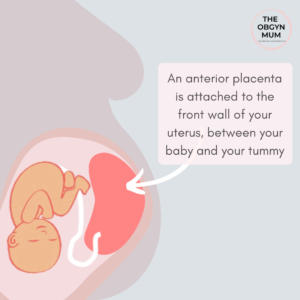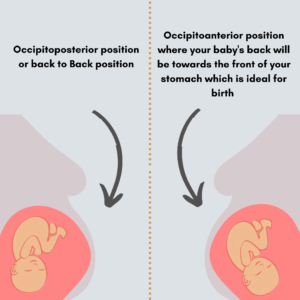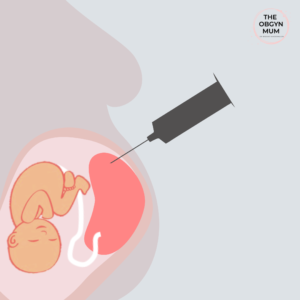You may have been told at a scan that you have an anterior placenta and this can often leave you with more questions than answers!
In this post, we will explore what this means for you and your baby?
What is your placenta?
The placenta is a pancake shaped organ that begins developing in your uterus from around week 4 of your pregnancy. The placenta develops where the fertilised egg has buried itself in the lining of your uterus. Your placenta is attached to the lining of the womb during pregnancy and is connected to you baby via the umbilical cord.
The function of your placenta is to help your baby grow and develop by bringing oxygen, nutrients and antibodies from your blood to your baby. It also helps get rid of any waste products from the baby by carrying them away and produces hormones that are needed during pregnancy.
Your placenta is expelled from your body during the third stage of labour which is usually about 5 to 30 minutes after your baby is born.
What does anterior placenta mean?
When a health care professional tells you that you have an anterior placenta they are talking about where your placenta is in your uterus. An anterior placenta simply means your placenta is attached to the front wall of your uterus, between your baby and your tummy.
Other people may have a posterior placenta (at the back) or a fundal placenta (positioned right at the top of the womb).

When will I know if I have an anterior placenta?
At your 20 week scan, your sonographer will check the position of your placenta. They will usually make a note of it in the scan report.
Should I be worried about an anterior placenta?
The front wall of your uterus is a normal place for the placenta to implant and it will still do its job of nourishing your baby.
There are some things to be aware of if you’re told your placenta is anterior.
Your baby’s movements
It’s important to get to know your baby’s movements and be aware of them throughout your pregnancy.
Most women can usually feel their baby move for the first time between 18 and 24 weeks. If this is your first pregnancy, you might not be able to feel your baby’s movements until you are more than 20 weeks pregnant.
An anterior placenta can make it harder to feel your baby move because your placenta is acting like a cushion between you and your baby. When your baby is very small, it may mean you dont perceive the movements as strongly as if your placenta was at the back or top of your uterus, but as your baby grows towards the end of the second/ beginning of the third trimester, you should continue to feel your baby move regularly.
You should never assume that having an anterior placenta is a reason why you can’t feel your baby move.
If you think your baby’s movements have slowed down, stopped or changed, it’s always best to get checked by contacting your midwife or maternity unit.
Your baby’s position in your womb
Having an anterior placenta means you baby is more likely to be in a back-to-back position; where your baby’s head is down in your womb, but the back of their head and back is against your spine. You may have heard the medical team for this; the occipito-posterior position.
If your baby is in a back-to-back position when you go into labour, it is still likely that your baby will turn so that it’s head is still down in your womb but their back will be towards the front of your stomach (occipito-anterior position).
This is the best position for birth. If this doesn’t happen it’s still possible to have a vaginal delivery but there are increased the chances of (1):
- a longer labour that is more painful
- a caesarean section
- assisted birth

Amniocentesis
There are some tests where an anterior placenta can mean they are more difficult to carry out including amniocentesis.
Amniocentesis is when a long, thin needle is put through your stomach into the amniotic sac to remove a sample of your baby’s cells to test for health conditions.

This is a test that not all women are offered. You will only be offered this test if the results of your screening tests show that your baby has a high risk of certain conditions, such as Down’s syndrome.
Having an anterior placenta can make amniocentesis more difficult. However, an ultrasound scanner is used to be able to visualise the placenta and guide the needle to reduce the risk of injury.
Regardless of where the placenta is, having amniocenteses during your pregnancy increases the risk of miscarriage. Having an anterior placenta does not increase this risk further .
The team looking after you will be able to discuss the procedure in full and answer any questions you have.
Low-lying anterior placenta
There is no evidence to suggest having an anterior placenta increases the likelihood of having a low-lying placenta.
A low-lying placenta is checked for during your routine 20-week ultrasound scan. If you are told that have an anterior placenta that is also lying low in your uterus, it could partially or completely block the cervix which is the baby’s way out!
However, it’s important to remember that the placenta migrates around your uterus during pregnancy. A low-lying placenta often moves into the upper part of the uterus by your due date.
90% of women who have a low-lying placenta at 20 weeks will have resolved later in the pregnancy (2). This doesn’t mean the placenta picks up and relocates, but it migrates upwards in the second trimester as the lower portion of the uterus stretches and grows.
If your placenta hasn’t migrated on your 32 week scan, the team looking after you will be able to discuss this in more detail and what your options are for giving birth.
If you have any concerns about having an anterior placenta, always discuss these with your midwife and the team looking after you during your pregnancy.
References
- PONKEY S. Persistent fetal occiput posterior position: obstetric outcomes. Obstet Gynecol. 2003;101(5).
- Jauniaux ERM, Alfirevic Z, Bhide AG, Belfort MA, Burton GJ, Collins SL, et al. Placenta Praevia and Placenta Accreta: Diagnosis and Management: Green-top Guideline No. 27a. BJOG An Int J Obstet Gynaecol. 2019;126(1).
